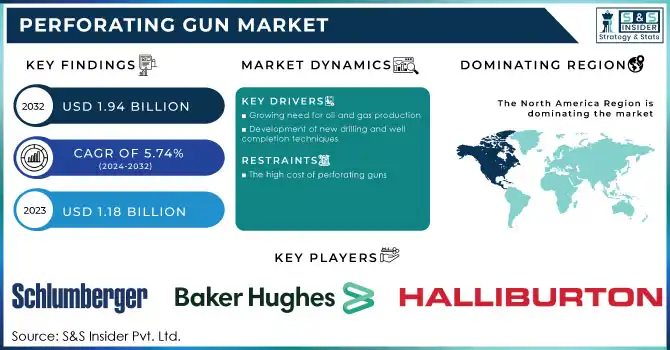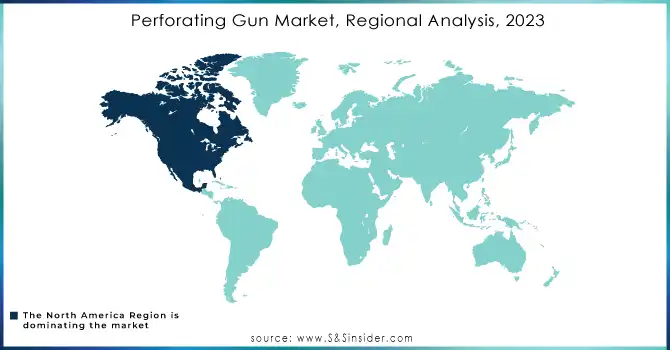Perforating Gun Market Report Scope & Overview:
The Perforating Gun Market was valued at USD 1.18 Billion in 2023 and is projected to reach USD 1.94 Billion by 2032, growing at a compound annual growth rate (CAGR) of 5.74% from 2024 to 2032.
The term "Perforating Gun" refers to a tool used in the oil and gas industry to create holes in the casing and cement of a wellbore. These holes allow for the flow of oil and gas into the wellbore, which can then be extracted for use. The perforating gun is typically made up of a series of explosive charges that are placed along the length of the tool. When the charges are detonated, they create small holes in the casing and cement, allowing for the flow of oil and gas. This process is critical to the success of oil and gas extraction, as it allows for the efficient and effective recovery of these valuable resources. As such, the perforating gun is an essential tool for any oil and gas company looking to maximize its production and profits.

Get more information on Perforating Gun Market - Request Sample Report
Perforating Gun market is a crucial component of the energy sector, as perforating guns are essential tools for drilling and completing oil and gas wells.In recent years, the Perforating Gun Market has experienced significant growth due to the increasing demand for energy resources and the development of new drilling technologies. As a result, many companies have entered the market, offering a wide range of perforating gun products and services.
Market Dynamics
Drivers
-
Growing need for oil and gas production
-
Increasing demand for energy
-
Development of new drilling and well completion techniques
The Perforating Gun Market is primarily driven by the increasing demand for oil and gas production. This demand has led to a surge in the use of perforating guns, which are essential tools for creating holes in oil and gas wells. As the global population continues to grow, the need for energy will only increase, making the Perforating Gun Market a crucial component of the energy industry. With advancements in technology and the development of new drilling techniques, the demand for perforating guns is expected to rise even further in the coming years. As such, the Perforating Gun Market is poised for significant growth and presents an excellent opportunity for investors and businesses alike.
Restrain
-
The high cost of perforating guns
Opportunities
-
Increasing demand for geothermal energy and mining
-
The growth of the oil and gas industry in developing country’s markets
Challenges
-
Shifting of focus towards renewable energy sources
In order to reduce the emission of harmful greenhouse gases, the government has implemented stringent regulations on drilling activities related to oil and gas. As a result, customers have begun to shift their focus towards adopting renewable energy sources. While this is a positive development for the environment, it can create challenges for the perforating gun market. As a result, companies that manufacture and sell perforating guns may face challenges in maintaining their market share.
Impact of Covid-19:
The COVID-19 pandemic has had a significant impact on the perforating gun market. The market has experienced a decline in demand due to the economic slowdown caused by the pandemic. The restrictions on travel and transportation have also affected the supply chain, leading to delays in the delivery of perforating guns. Detailed information is included in the final report.
Impact of Russia-Ukraine War:
The ongoing conflict between Russia and Ukraine has had a significant impact on the global economy, including the oil and gas industry. The market for perforating guns has been impacted by the Russia-Ukraine war in several ways.Firstly, the conflict has led to a decrease in oil and gas production in the region. This has resulted in a decrease in demand for perforating guns, as fewer wells are being drilled.Secondly, the sanctions imposed on Russia by the international community have made it difficult for Russian companies to export their products, including perforating guns. This has created an opportunity for other countries to enter the market and fill the gap left by Russian companies.Finally, the instability in the region has made it difficult for companies to operate in Ukraine and Russia. This has led to a decrease in investment in the region, which has further impacted the perforating gun market.
Impact of Recession:
The perforating gun market has been significantly affected by the recent recession. The recession has led to a decrease in demand for oil and gas, which has subsequently impacted the demand for perforating guns used in the exploration and production of these resources. Detailed information is included in the final report.
Key Market segmentation
By Type:
-
Expendable
-
Semi-expendable
-
Retrievable
By Gun Type:
-
Through tubing hollow carrier gun system
-
Wireline conveyed casing gun system
-
Through tubing exposed gun system
-
Tubing conveyed perforation system
By Orientation:
-
Internal
-
External
By Explosives
-
CyclotrimethyleneTrinitramine (RDX)
-
CyclotetramethyleneTrinitramine (HMX)
-
Hexanitrosilbene (HNS)
By Carrier Type
-
Hollow Carrier
-
Expandable Shaped Charged Gun
-
Others
By Depth:
-
Up to 3,000 ft.
-
3,001 – 8,000 ft.
-
Above 8,000 ft.
By Application:
-
Onshore
-
Offshore
Regional Analysis
The Perforating Guns Market is currently experiencing a surge in North America, where the region dominates and is expected to maintain its dominance over the forecast period. This growth is largely due to the increased production of oil and natural gas in the area. As a result, the demand for perforating guns is growing across various industries, including construction, oil and gas, and automotive, which will further drive the market's growth. Additionally, the presence of key players in this region is helping to expand the market for perforating guns.
However, the Asia-Pacific region is expected to grow at the highest CAGR during the forecast period of 2023-2030. This growth is attributed to the presence of conventional onshore and offshore oilfields, as well as the increasing demand for energy from emerging countries such as India and China. As a result, the perforating gun market in this region is expected to experience significant growth in the coming years.

Get Customized Report as per your Business Requirement - Request For Customized Report
REGIONAL COVERAGE:
-
North America
-
USA
-
Canada
-
Mexico
-
-
Europe
-
Germany
-
UK
-
France
-
Italy
-
Spain
-
The Netherlands
-
Rest of Europe
-
-
Asia-Pacific
-
Japan
-
south Korea
-
China
-
India
-
Australia
-
Rest of Asia-Pacific
-
-
The Middle East & Africa
-
Israel
-
UAE
-
South Africa
-
Rest of Middle East & Africa
-
-
Latin America
-
Brazil
-
Argentina
-
Rest of Latin America
-
Key Players
The major players are Halliburton, Schlumberger Limited, Baker Hughes Company, Weatherford International, NOV Inc, Northern Colorado Manufacturing, LLC, Hunt & Hunt Ltd, Core Laboratories, DMC Global, and Schweitzer-Mauduit International, Inc.
| Report Attributes | Details |
| Market Size in 2022 | US$ 1105 Mn |
| Market Size by 2030 | US$ 1683 Mn |
| CAGR | CAGR of 5.4% From 2023 to 2030 |
| Base Year | 2022 |
| Forecast Period | 2023-2030 |
| Historical Data | 2020-2021 |
| Report Scope & Coverage | Market Size, Segments Analysis, Competitive Landscape, Regional Analysis, DROC & SWOT Analysis, Forecast Outlook |
| Key Segments | •By Type (Expendable, Semi-expendable, Retrievable) •By Gun Type (Through tubing hollow carrier gun system, Wireline conveyed casing gun system, Through tubing exposed gun system, Tubing conveyed perforation system) •By Orientation (Internal, External) •By Explosives (CyclotrimethyleneTrinitramine (RDX), CyclotetramethyleneTrinitramine (HMX), Hexanitrosilbene (HNS)) •By Carrier Type (Hollow Carrier, Expandable Shaped Charged Gun, Others) •By Depth (Up to 3,000 ft., 3,001 – 8,000 ft., Above 8,000 ft.) •By Application (Onshore, Offshore) |
| Regional Analysis/Coverage | North America (USA, Canada, Mexico), Europe (Germany, UK, France, Italy, Spain, Netherlands, Rest of Europe), Asia-Pacific (Japan, South Korea, China, India, Australia, Rest of Asia-Pacific), The Middle East & Africa (Israel, UAE, South Africa, Rest of Middle East & Africa), Latin America (Brazil, Argentina, Rest of Latin America) |
| Company Profiles | Halliburton, Schlumberger Limited, Baker Hughes Company, Weatherford International, NOV Inc, Northern Colorado Manufacturing, LLC, Hunt & Hunt Ltd, Core Laboratories, DMC Global, and Schweitzer-Mauduit International, Inc. |
| Key Drivers | • Growing need for oil and gas production • Increasing demand for energy • Development of new drilling and well completion techniques |
| Market Opportunities | • Increasing demand for geothermal energy and mining • The growth of the oil and gas industry in developing country’s markets |

